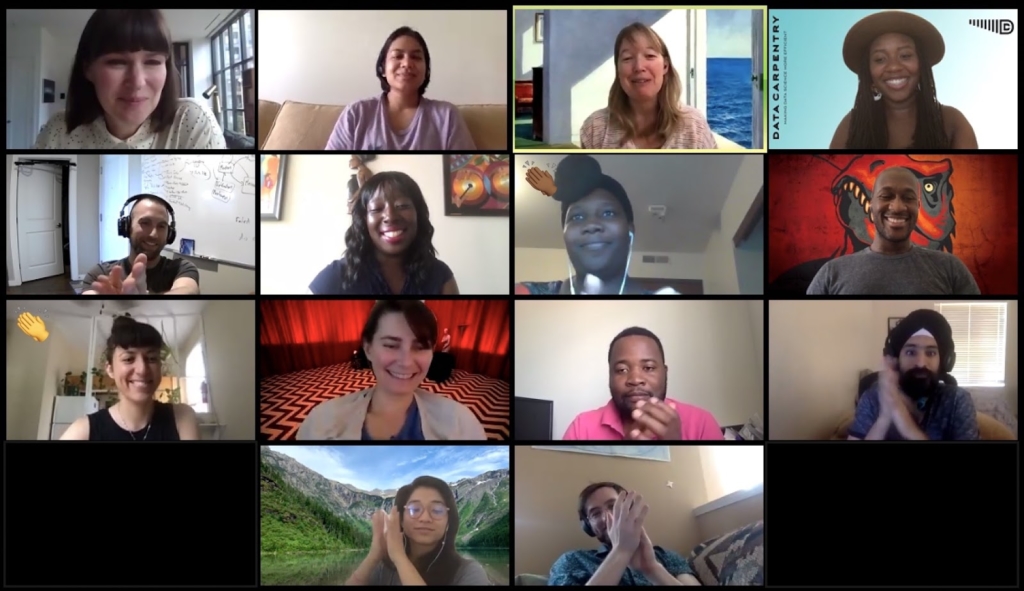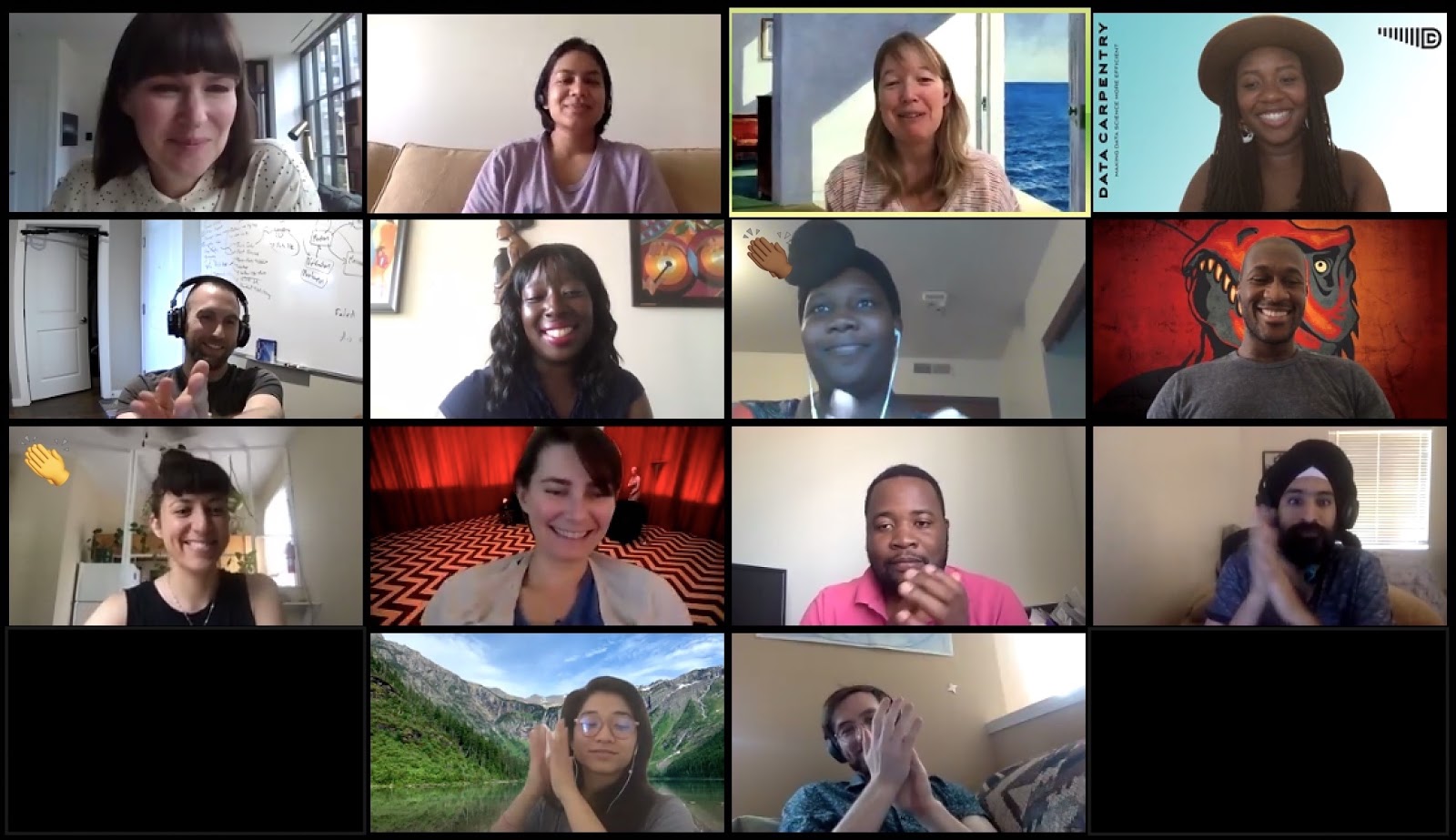
After five years of running the Data Science for Social Good (DSSG) summer program in the eScience Institute’s open studio space – where project leads spend at least two days per week with full-time student fellows and in-house data scientists for ten weeks – the program has now completed its first successful summer remotely.
The program, which was moved online due to the coronavirus pandemic, involves close collaboration via interdisciplinary teams. Two projects that were conducive to a remote environment were selected to provide extra support, compared with 3-4 projects in prior years. “That allowed us to select two extremely topical projects, which I believe really helped with keeping everyone focused and motivated,” said Vaughn Iverson, a Senior Research Scientist at the eScience Institute who has been working with DSSG project teams for the last five years.
The projects were Detection of Vote Dilution: New tools and methods for protecting voting rights and Identifying Coronavirus Disinformation Online. Each team consisted of four student fellows, two project leads, and two data scientists from the eScience Institute. Program-wide activities were limited to 9:00 a.m. to 3:00 p.m. PST to accommodate participants living in different time zones, and each team established its own group working hours.
The transition to a remote program was led by DSSG Program Chair Anissa Tanweer and Program Director Sarah Stone, and began with seeking advice from experts in virtual team building and program management. More than 40 interviews were conducted with prospective fellows, in addition to a rigorous review of project proposals, to ensure a good match between students and projects. Well-scoped projects rooted in current events, with data that was already available, showed the greatest promise for garnering necessary resources from partner organizations at a time in which many organizations have experienced shifting priorities due to the pandemic. Project leads with experience working remotely provided a strong advantage.
To ensure adequate technological access, a survey was conducted in advance to assess each team member’s remote work conditions, such as internet speed, hardware, and auditory or visual distractions. Equipment and other support were provided as needed, with funding from a Micron Advancing Curiosity Award. In an attempt to mimic the widely used group collaboration whiteboards of the Data Studio, participants received Amazon Fire tablets on loan along with access to an online whiteboard app, although they were not highly utilized because teams preferred their own collaboration methods.
An internal website was already in the works prior to the pandemic, and launched this summer to provide programmatic information to participants in a streamlined format, from the code of conduct, calendar and participants’ chart to tutorial and workshop descriptions, community resources and program deliverables. Making this information easily findable was particularly important in a remote environment to reduce extra time online.
Previous DSSG icebreakers have involved throwing a beach ball around the studio, serving group meals and snacks, and going on a scavenger hunt around the University of Washington’s Seattle campus. To replace these in-person social activities, multiple introductory and weekly events were held. Care packages were sent to participants with a DSSG mug and Seattle-themed snacks. Social events included an “Online Office Games” session and “Murder mystery” event with teambuilding.com and an introductory icebreaker with Yotribe. The “Donut” plugin was added to the messaging platform Slack, which has been a staple in the program for years. This plugin randomly pairs participants for 15-minute chats each week. Every Monday morning began with an icebreaker activity and personal update from all participants. Program leaders held brief weekly check-ins with each fellow individually to provide an additional avenue for communication.
A suite of tutorials and workshops, led by data scientists and staff at the eScience Institute and volunteers from the research community, were slightly scaled down this year to reduce online overload and focus on the particular needs of each project. Fellows participated in 12 tutorials and 6 workshops covering topics including Git & GitHub, coding standards and documentation, machine learning, reproducible data science, public speaking, stakeholder engagement and ethics. There were two additions to account for the new environment: Team Communication and Collaboration led by remote facilitator P. “Charley” Haley, and How to Work Remotely led by teambuilding.com. A “language helpline” channel was added to Slack to help resolve coding questions throughout the program.
Collaborative work between fellows was often conducted via zoom work sessions to mimic the in-person meeting room environment, and Slack continued to be a valuable communication tool. The community-building activities and group work style resulted in cohesive project teams, in which the four fellows on each team developed strong bonds with each other, and project leads and data scientists were closely involved through Slack discussions and meetings. However, there were still noticeable differences from the in-person program. Vaughn Iverson said, “In terms of communication, the thing I really missed was just ‘being present nearby’ with the team while they were working. I’m a big fan of observational ‘management by being present’ and that’s proven to be difficult to replicate in the remote format.”
Connecting participants to the larger eScience network also proved more difficult. Although introductions were established through workshops and tutorials, it was more challenging to build sustained connections to help the fellows make full use of available resources outside of the core program without the social and incidental interactions of a shared physical space.
Other challenges of the remote environment included zoom burnout, which reminded organizers of the need for built-in breaks, and a general sense that certain discussions and collaborative tasks required more time to complete. Viewing a teammate’s screen virtually often felt more formal and less organic than looking over someone’s shoulder. Structured meetings and check-ins were particularly important to ensure that feedback was shared and received without chance encounters.
Running the program remotely also provided unexpected benefits, such as the flexibility to balance personal and family obligations. The virtual meeting environment allowed for a diverse set of participants from across the U.S. to join weekly Career Conversations and meetings with project stakeholders, as well as supporting a large turnout of more than 130 people for final presentations on August 19th, which were livestreamed as a zoom webinar.

